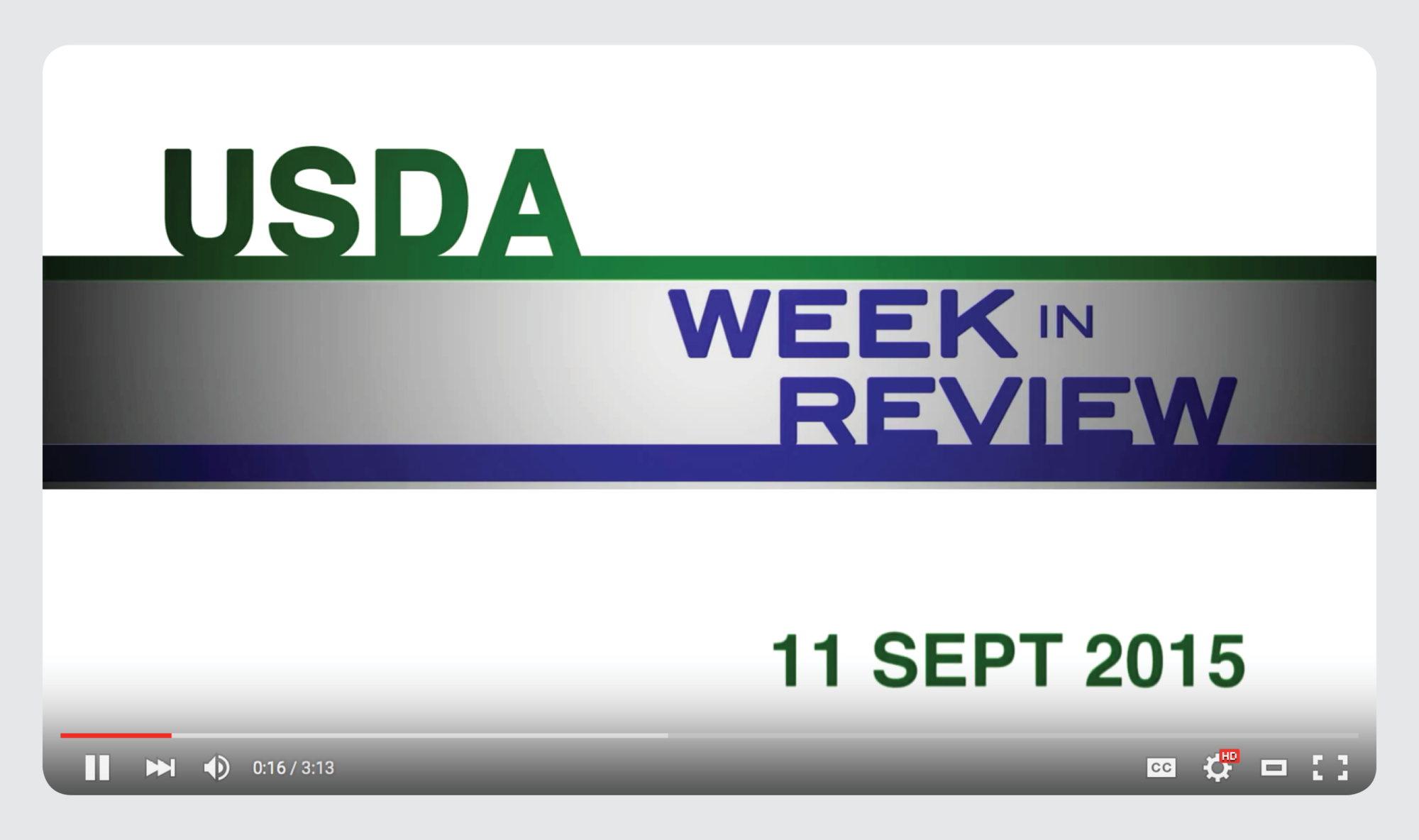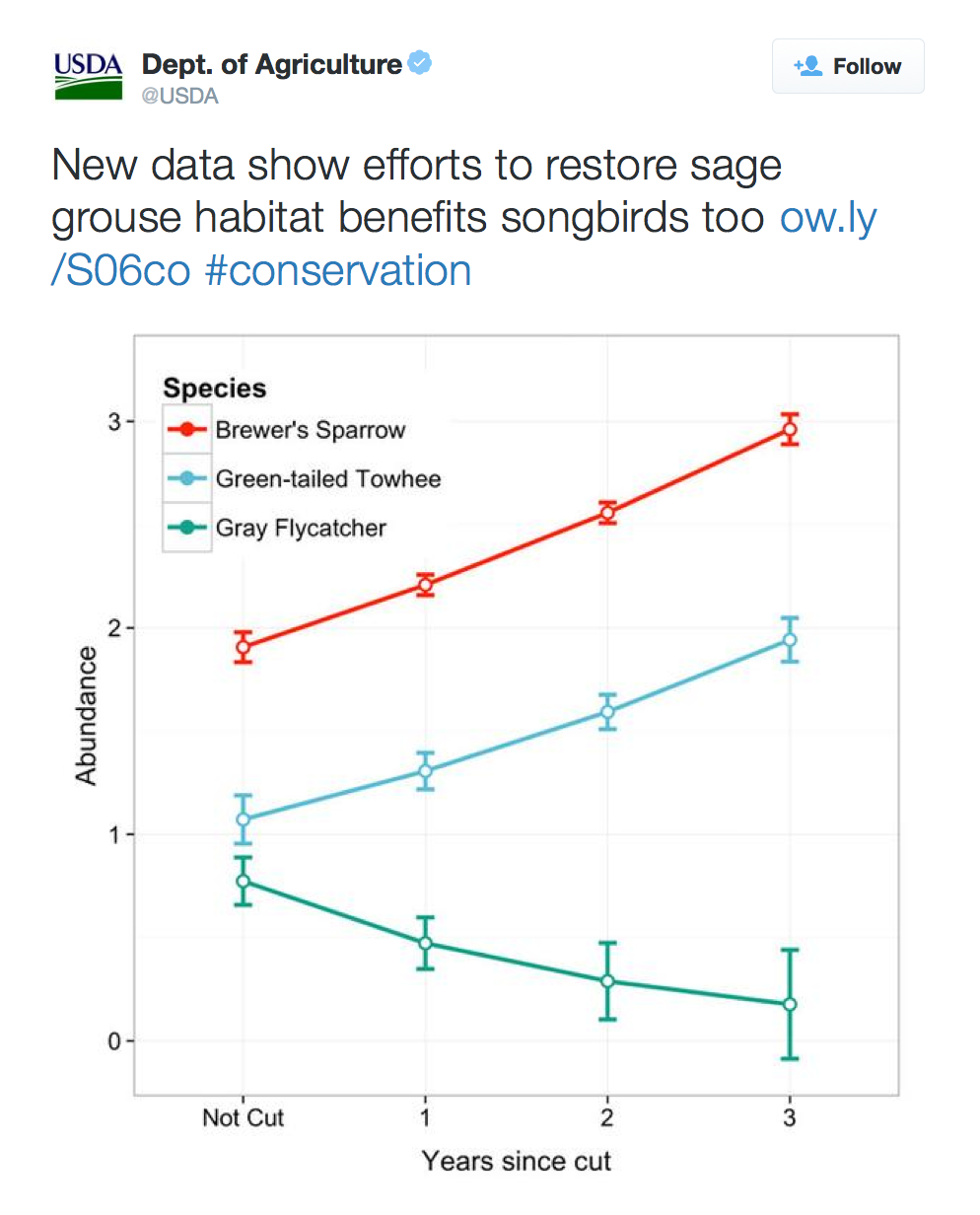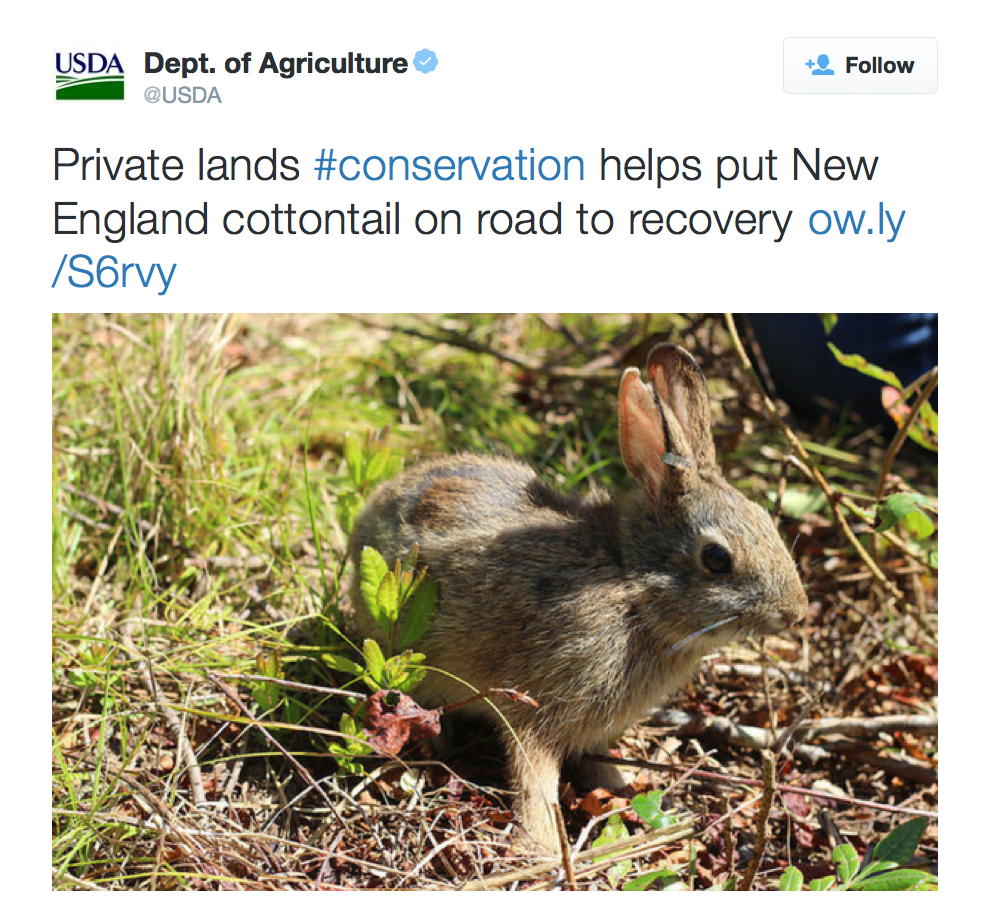Having trouble viewing this email? View it as a Web page.


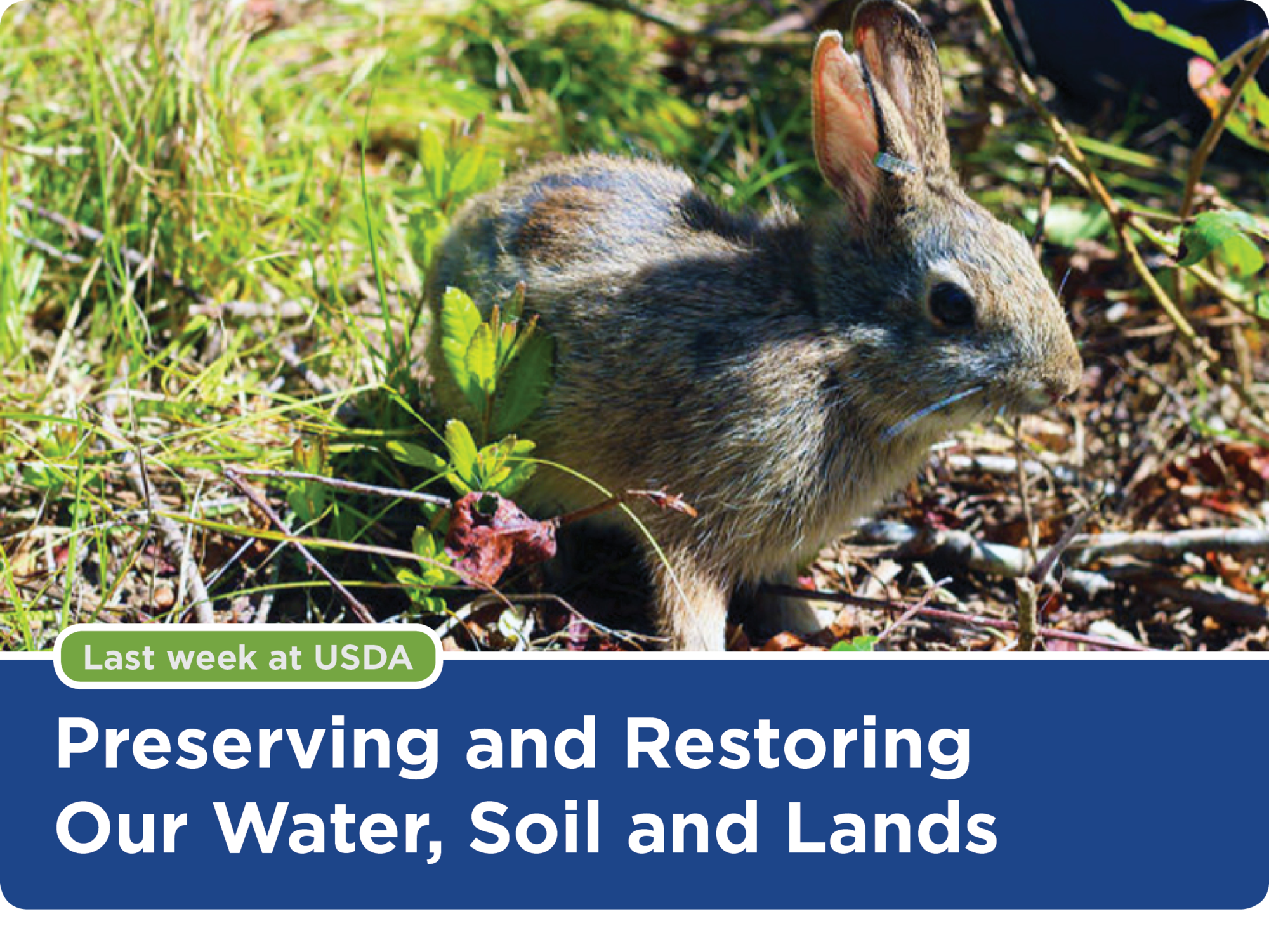
ICYMI, here's what happened last week at USDA:
Throughout the month of September we are focused on the ways USDA is implementing smart policies that work to preserve our land, water, soil and natural resources and help ensure the long-term health of critical ecosystems and the countless species who rely on them.
As part of that mission, USDA’s Natural Resources Conservation Service works with private land-owners and managers to restore habitat across the United States. Last week, in collaboration with the U.S. Department of Interior, we made the exciting announcement that a partnership uniting foresters, farmers, birdwatchers, biologists, hunters and other conservationists has saved the New England cottontail from needing to be protected under the Endangered Species Act. Widespread habitat loss since the 1960s impacted New England cottontail numbers, but NRCS’s work with landowners on habitat restoration is successfully working to recover cottontails in the region showing once again the power of partnerships to reach ambitious but achievable goals. You can read about the work of one New England farmer to voluntarily restore cottontail habitat here on our blog.
In addition to that news, Secretary Vilsack announced that 21 states will receive grants through the Biofuel Infrastructure Partnership to supply more renewable fuel options to Americans at the pump. This investment will provide an estimated double the number of stations that offer intermediate blends of ethanol, and is part of on approach USDA is using to support America's clean energy economy and cut carbon pollution.
Thanks for tuning in last week, and continue following along this month or join the conversation using hashtag #conservation.

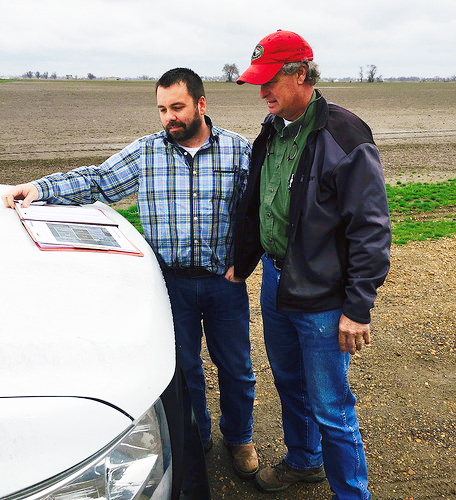
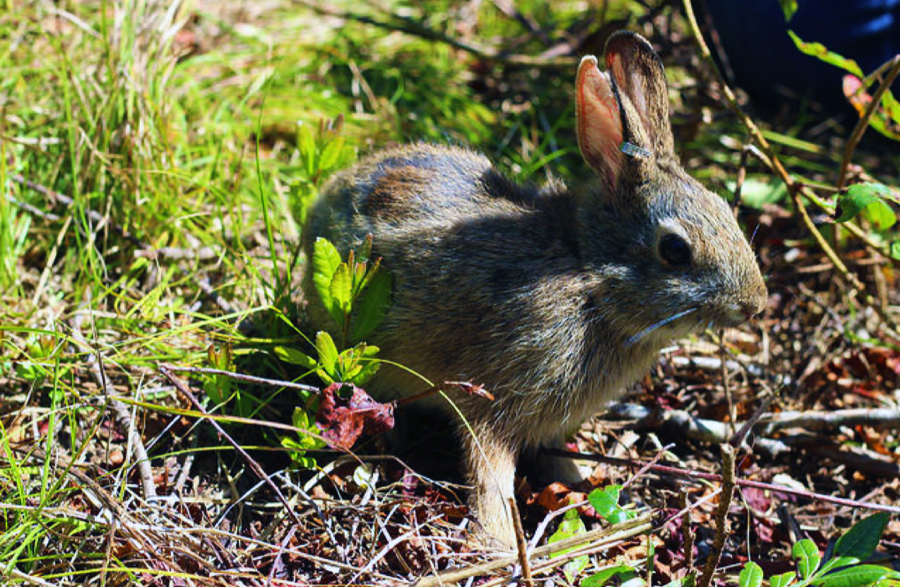
The New England cottontail is the region’s only native rabbit.
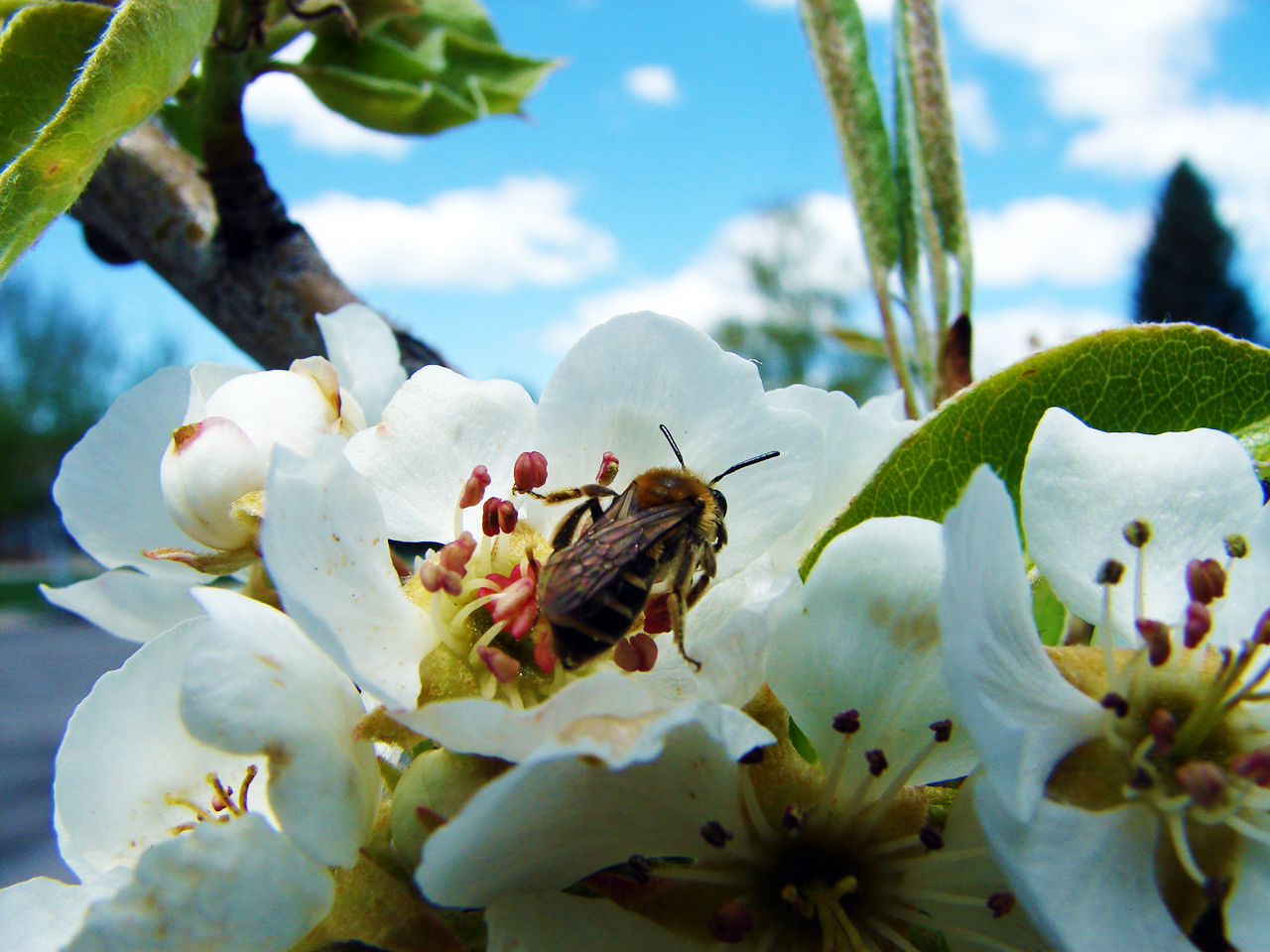
A native Andrena bee species gathers nectar and pollen from a pear flower.
All images available in Flickr.

Private Lands Conservation Helps Put New England Cottontail on Road to Recovery
Wildlife and working lands go hand in hand. Today, thanks to the hard work of private landowners and land managers, the New England cottontail will not need protection under the Endangered Species Act. Widespread habitat loss since the 1960s impacted New England cottontail numbers. But people like Rick Ambrose have restored habitat on private lands, putting the cottontail on the road to recovery.
Conserving Water, Soil and Habitat on Private Lands
For 80 years, USDA’s Natural Resources Conservation Service (NRCS) has worked with agricultural producers to make conservation improvements to their farms, ranches and forests. These improvements help clean and conserve water, boost soil quality and restore habitat, and also make their agricultural operations more resilient.
Being Fire Wise is an Easy Way to Prepare for Fire Season
We’ve all seen the heart-wrenching images on TV: lives and property destroyed by wildland fire. And, this fire season, with over eight million acres burned, we are seeing these images more frequently. Most of us think nothing can be done to protect a home from the onslaught of a raging wildland fire. Don’t be fooled, there is a way to protect your home. The U.S. Forest Service calls it Fire Wise.
New Data Show Efforts to Restore Habitat for Sage Grouse Benefits Songbirds, Too
Restoring sagebrush ecosystems not only benefits ranching and sage grouse but other wildlife, too. New data show that populations of Brewer’s sparrow and green-tailed towhee, two sagebrush-dependent songbirds, climbed significantly in places where invading conifer trees were removed.
Responding to Oak Wilt and Climate Change on the Menominee Nation Forest
Standing in a disturbed patch of forest, Menominee forester Jeff Grignon looks around and explains, “My role is to regenerate the forest, maintain the forest, create diversity, and look toward the future.” This task is becoming increasingly challenging as growing forest health issues intersect with additional stressors brought about by climate change in the forests of the Menominee Nation and elsewhere.
New Guide Helps Citizens Customize Their Gardens for Native Bees
Dogged by pests, pathogens, poor nutrition, and other problems, the European honey bee is having a rough time these days. The bee pollinates over 90 different kinds of fruit, vegetable and nut crops. These same crops are also pollinated by native bees, particularly on smaller or diversified farms and especially in home gardens.


Feds Say New England Cottontail Doesn't Need Protection (Associated Press)
The federal government said Friday that public and private conservation efforts have helped the New England cottontail rebound to the point where it can be taken off the list of species under consideration for protection. The small, brown rabbit has been threatened by a loss of habitat throughout its range in Maine, New Hampshire, Massachusetts, Connecticut, Rhode Island and New York.
Cottontails are bouncing back in New England (Boston.com)
Fear not, cottontail lovers, the bunnies are making a comeback. The New England cottontail was once on its way to endangered species status, but through conservation efforts is now able to be removed from the list, The Boston Globe reports.
Rabbit species kept off endangered list (The Hill)
A rabbit species native to New England is not imperiled enough to warrant protection as an endangered species, federal officials ruled Friday. New England cottontail, which inspired “The Adventures of Peter Cottontail” by Thornton Burgess, is sufficiently protected by a public-private partnership formed by farmers, biologists, wildlife specialists and others, and does not need listing under the Endangered Species Act, the Fish and Wildlife Service (FWS) declared.
USDA awards $100M grants to 21 states for renewable fuels (Associated Press)
Agriculture Secretary Tom Vilsack says 21 states will receive funding to increase the number of gas pumps that offer renewable fuels. Vilsack made the $100 million Biofuel Infrastructure Partnership announcement on Thursday morning in Champaign. The USDA says the money will pay for about 5,000 pumps at more than 1,400 fueling stations.
N.E. cottontail rabbit won’t be on endangered list, thanks to restoration efforts (Concord Monitor)
The Secretary of the Interior is in New Hampshire today, partly to announce that the New England cottontail won’t be put on the endangered-species list because restoration efforts here and in other parts of New England have stemmed its population decline. The Globe has a story about it today.
Ag chief: 'What's happening here is the future' (News Gazette)
During this morning’s visit to campus, U.S. Agriculture Secretary Tom Vilsack announced that Illinois will receive about $12 million of federal funding for biofuel infrastructure. The money will be used to pay for 428 new renewable fuel pumps that pump E-85 and E-15 gasoline at stations across the state.
USDA Provides Grants For More Ethanol Pumps (Iowa Public Radio)[AUDIO]
Soon across Iowa, the Midwest, and parts of the west and south, it will be more convenient for drivers to fill their tanks with ethanol-blended gasoline. The USDA is providing $100 million in matching grants to 21 states, to expand the number of pumps that can dispense gasoline with higher blends of the bio fuel.
USDA awards $100 million to 21 states for e15 pumps (Politico 9/10)
The Agriculture Department is providing $100 million to 21 states to expand the available gas pumps for higher blends of ethanol. In a call today with reporters, Agriculture Secretary Tom Vilsack said he expects the grants from the Biofuel Infrastructure Partnership will be matched by states and private companies to fund 4,880 new pumping stations that are capable of dispensing e15 and e85. Most pumps are currently only able to take e10, though new cars can run on e15. "We are going to work hard to make consumers have access [to e15] because when they do, they buy it," Vilsack said. "This is an important industry. It's a job creator. It's better for the environment and it does provide stability" in rural communities. The states receiving the funds are Colorado, Florida, Illinois, Indiana, Iowa, Kansas, Louisiana, Maryland, Michigan, Minnesota, Missouri, Nebraska, North Carolina, North Dakota, Ohio, Pennsylvania, South Dakota, Texas, Virginia, West Virginia and Wisconsin.
Minnesota among states in line to add hundreds of ethanol pumps (Star Tribune)
Minnesota will get millions of federal dollars to help build hundreds more ethanol fuel pumps around the state. U.S. Secretary of Agriculture Tom Vilsack on Thursday named the state as one 21 across the country that will share $100 million to expand the use of renewable fuels in vehicles. The exact amount of money headed for Minnesota remains to be determined.
Michigan is getting more E-15 fuel pumps (Michigan Radio)
Michigan will have about 89 new E-15 pumps soon, due to federal grants. Currently, most gasoline pumps in the state deliver gas with 10% ethanol, a fuel made from corn. The federal government is encouraging wider distribution of gas with higher blends of ethanol. U.S. Secretary of Agriculture Tom Vilsack says GM, Fiat Chrysler, and Ford have been making vehicles that run on E-15 and higher blends for years.
USDA issues grants to Iowa and other states for ethanol gas pumps (Radio Iowa)
U.S. Agriculture Secretary Tom Vilsack announced today that Iowa is among 21 states receiving grants to help increase the availability of biofuels. The U.S.D.A. will issue $100 million to the states to add the infrastructure needed to roughly double the number of gas pumps delivering higher blends of corn-based ethanol.
Federal biofuels grant should expand blender pumps in Iowa (Quad City Times)
Iowa motorists with flex-fuel vehicles may find more options for purchasing gasoline blended with higher levels of ethanol at service-station pumps thanks to a federal grant the state will be receiving, officials said Thursday.
Editorial: Vilsack ready to talk rural (Cedar Rapids Gazette)
I speak to a lot of groups, and I speak to most of those groups about rural development and rural life for the following reasons: Rural America has a significant number of the high-poverty counties in this country. In fact, 80 percent to 85 percent of high-poverty counties, especially among children, are in rural areas.

"PETER COTTONTAIL" NO LONGER AN ESA LISTING CANDIDATE
Broadcast Date:
Fri, September 11, 2015
The rabbit species that inspired a famous children's book continues to recover from the threat of extinction, thanks to voluntary conservation efforts. (Rod Bain and USDA Under Secretary Robert Bonnie)
ACTUALITY: WORKING LANDS FOR HABITAT
Broadcast Date:
Fri, September 11, 2015
USDA Under Secretary Robert Bonnie explains how efforts like a Natural Resources Conservation Service program is conserving habitat of threatened species while remaining as workable farm, ranch, and forest lands.


